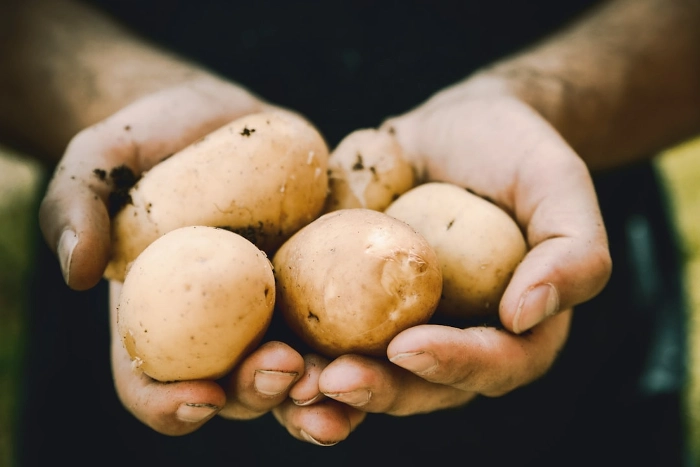Harvest, Cure and Store Potatoes: Tips for Longevity

Disclosure: Some of the links in this article may be affiliate links, which can provide compensation to me at no cost to you if you decide to purchase. As an Amazon associate I may earn on qualifying purchases.
The Ultimate Guide to Harvesting, Curing, and Storing Potatoes: Tips for Long-Term Preservation
Potatoes are one of the most versatile and widely loved vegetables. They are easy to grow and can be harvested and stored for long periods, ensuring a steady supply for months. However, the process of harvesting, curing, and storing potatoes requires some careful attention to ensure their quality and longevity.
potatoes growing in the garden
In this blog, we will take you through the steps to achieve a successful potato harvest and discover some varieties that store exceptionally well.
**1. Choosing the Right Potato Varieties:**
Before delving into the harvesting process, it's essential to select the right potato varieties that have good storage potential. Some potatoes are naturally better at storing for extended periods due to their thicker skin and low water content.
Red potatoes usually don't store and keep as long as yellow or white varieties of potatoes. Thin-skinned potatoes don't last as long in storage as those with thick skins, such as russets. Late-maturing varieties almost always store better than early types
The OSU Extension Service recommends the following varieties: Elba, Katahdin, Red Chieftain, Yukon Gold, Burbank Russet, German Butterball, Yukon Gem, Rose Finn Apple Fingerling, Russian Banana Fingerling, Red Pontiac, All Blue, and Kennebec.
Whenever possible, plant only certified, healthy seed potatoes.
**2. Harvesting Potatoes:**
The timing of the potato harvest is crucial to ensure optimal storage potential. Harvesting is generally done when the potatoes have reached their full size, and the plants' foliage yellow and dies back. Not watering just before harvest will help to toughen the skins which is needed for storage.
Potato vines starting to die back
Follow these steps to harvest your potatoes:
**a. Timing:** Potatoes are typically ready for harvest when the vines have died all the way back. As the vines die back before harvest, it allows the skin to thicken, promoting better storage ability.
**b. Digging:** Gently dig up the potatoes using a fork or spade, taking care not to damage them. Avoid using tools that could pierce or bruise the tubers.
**c. Handling:** Handle the freshly harvested potatoes with care, as any cuts or bruises can lead to spoilage during storage. You will just need to brush off the dirt to get ready for storage, but it you have clay soil on the potato, you will need to wash off the potato. Make sure you completely dry the potato if you had to wash it.
**3. Curing Potatoes:**
Curing is a crucial step in the storage process that helps to toughen the skin and heal any minor injuries acquired during harvest.
Follow these steps to cure your potatoes properly:
**a. Drying:** Lay the freshly dug potatoes in a single layer in a dry, well-ventilated area, away from direct sunlight. Let them sit for about 10 days to 2 weeks to allow the skins to thicken and any cuts or bruises to heal.
**b. Optimal Conditions:** The curing process requires a temperature of around 50-60°F (10-15°C) and high humidity. Avoid exposing the potatoes to frost or excessive heat during this period.
**4. Storing Potatoes:**
Once your potatoes have been properly cured, it's time to store them for the long term(4-9 months). The right storage conditions can significantly impact their shelf life:
**a. Dark and Cool:** Store potatoes in a dark, cool place to prevent them from sprouting or turning green. Ideal temperatures for storage are between 40-45 degrees F. Higher temperatures will cause decay and sprouting overtime.
**b. Ventilation:** Good ventilation is essential to prevent the accumulation of excess moisture, which can lead to rotting. Use well-ventilated containers, burlap sacks, or perforated plastic bags.
**c. No Refrigeration:** Never store potatoes in the refrigerator, as the cold temperatures lower that 40 degrees can convert the starches into sugars and affect their taste.
**d. Check Regularly:** Periodically check your stored potatoes for any signs of spoilage or rot. Remove any affected ones to prevent them from spoiling the entire batch. If any potatoes have green skin and the green has penetrated the potato, throw it away because it could make you sick if ingested.
.
By following these steps, you can ensure that your potato harvest stays fresh and delicious for an extended period. Having a bountiful supply of well-preserved potatoes will add a delightful touch to your meals throughout the year.
Happy gardening and happy storing!
Related Articles:
19 Shallow Rooted Plants for Your Raised Beds
Create A Wildflower Meadow: Our Simple Guide
The Ultimate Guide for Choosing The Best Shovels for Yard Work or Gardening
How to Shovel Snow Without Back Pain: An Ergonomic Guide to Snow Removal
5 Tips for Saving Flowers Seeds
Disclosure: Some of the links in this article may be affiliate links, which can provide compensation to me at no cost to you if you decide to purchase. As an Amazon associate I may earn on qualifying purchases.



